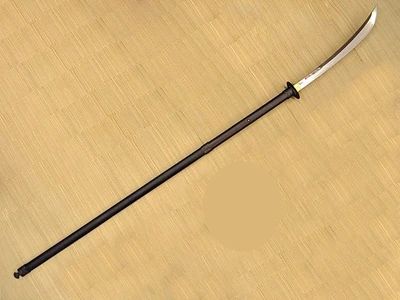Now some of you might be wondering why I am talking about a Japanese weapon on a blog about Chinese weapons.
Well, if you didn't know this, many aspects of the old Japanese culture, including their weapons of war, were highly influenced by the Chinese. The katana, or tachi, was merely the latest in an evolutionary chain, linking back to the Chinese Tang Dynasty horizontal saber (唐朝的横刀) that the Japanese called, chokutō (直刀) or more specifically, the straight, angular blade style, kiriha zukuri (切刃造).
 |
| a 9th century Tang Dynasty style chokutō from a Japanese collection, with lanyard hole & scabbard suspension mounts |
Likewise several other Japanese weapons have Chinese counterparts. One of which is the naginata (薙刀).
The naginata is a polearm, consisting of a curved, single-edged blade, attached to the end of a long pole. The blade is usually shorter than a katana, typically around 30-60cm. The overall blade shape is somewhat different. However, many of the fittings used on naginata resemble those which are seen on katana, such as the disc-shaped hand guard, or tsuba, and the blade collar, or habaki.
The naginata is a unique weapon among Japanese weapons, because it combines the aspects of both a sword and a polearm. It also has its own implications within Japanese culture. It was originally a weapon of the samurai class, but gradually it became more associated with sohei (Buddhist warrior monks), ashigaru (common foot soldiers), and finally, female samurai.
One might assume that naginata rose to prominence in Japan sometime around or before the 12th century C.E. Its peak time of use was between the Mid-Kamakura, Nanbokucho, and Muromachi periods. (1192-1573 C.E.)
This of course brings me to its Chinese counterpart, the Mei Jian Dao (眉尖刀)
 |
| depiction of a Mei Jian dao from the Wu Bei Zhi manual |
It bears an uncanny resemblance to the naginata, not only in appearance, but also construction (pinned-tang), function (anti-cavalry), and name.
What I mean by this is that in the Japanese language there are often several different words for expressing the same concept, using different kanji. When one looks up the word "naginata" in a dictionary, these are the typical alternative kanji forms: 長刀、眉尖刀
They all can be read with the same pronunciation, "naginata", and are used to express the same general concept, but the specific meanings of the individual kanji are different. However, the point I am trying to make here is that these kanji (眉尖刀) are used to describe both weapons, (which I believe are essentially the same).
It is also an accepted possibility that the naginata was originally brought over to Japan from China.
The one weakness in my theory is that a lot of this is supposition on my part. It's possible that the naginata was invented first, and the mei jian dao is merely a Chinese imitation of it. The mei jian dao was not a common weapon, nor has it been discussed at length among the historical weapons community (possibly because they also don't know what to think about it). Nevertheless, I do think it is interesting to find another close correlation between the weapons of these two different cultures.
